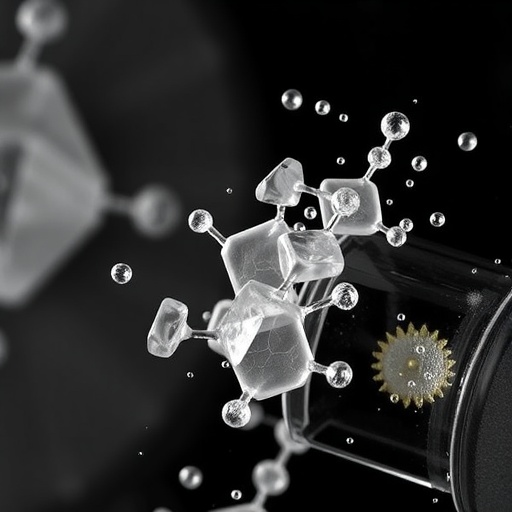In recent research, a critical investigation into the mechanisms governing precipitate formation during the mixing of nafamostat mesylate solution with dialysate has come to the forefront. Nafamostat mesylate, primarily known for its role as an anticoagulant and protease inhibitor, becomes significantly relevant in contexts associated with kidney dialysis. The dialysis treatment, which often requires efficient anticoagulation to prevent clotting in the circuit, necessitates extensive understanding of the physicochemical interactions taking place when mixing medications with dialysate solutions.
The study, undertaken by a collaborative team of researchers led by Okamoto, Oji, and Nakashima, sought to delineate the intricacies underlying precipitate formation, which can lead to severe complications during dialysis treatments. Understanding these mechanisms is pivotal not only for ensuring patient safety but also for optimizing the efficacy of nafamostat mesylate in the renal dialysis setting. The potential for precipitate formation presents a risk that could substantially affect treatment outcomes.
One of the primary motivators behind this research was the alarming reports and clinical observations indicating that precipitates could form when nafamostat mesylate interacted with certain components of the dialysate. These observations raised concerns about the safety and efficacy of dialysis when this medication is utilized. The team employed a range of analytical techniques to systematically investigate how and why these precipitates were formed, informing clinicians and patients alike of the risks involved.
Through their comprehensive communication of findings, the research team highlighted that the interaction between nafamostat mesylate and various ions present in the dialysate could lead to the crystallization of solid precipitates. This understanding is crucial as it provides actionable insights that could potentially mitigate risks associated with using nafamostat during dialysis, especially in patients who might have varying metabolic states.
To further elucidate the mechanisms behind these interactions, the researchers used techniques such as spectroscopy and microscopy to observe the particles formed in real-time. The analyses revealed that the conditions under which the dialysis was administered—including temperature, pH, and concentration of constituents—significantly influenced the likelihood of precipitate formation. These findings bring forth critical implications for clinical protocols that guide how medications are mixed and administered alongside dialysis treatments.
Moreover, the research does not just stop at identifying the problem but extends its scope to propose strategies for prevention. By adjusting specific parameters within the dialysate or refining the formulation of the nafamostat mesylate itself, the team suggests pathways to effectively reduce or eliminate the risk of precipitate formation. This aspect of the study is particularly vital for practitioners who strive to optimize dialysis processes while ensuring their patients’ safety.
Importantly, the research team also points to the broader implications of their findings extending beyond nafamostat alone. Many medications utilized in conjunction with dialysis could potentially face similar precipitate-related complications. By understanding the underlying mechanisms identified in this study, further research can explore the limits and capabilities of other compounds and how they interact within the dialysis setting.
In addition to clinical implications, the findings hold significant importance for the pharmaceutical industry as well. Knowledge gained from this research may steer drug formulation experts toward designing next-generation dialysis-compatible anticoagulants with minimized risks of precipitate formation. The goal is to enhance patient outcomes through safer medication practices in renal care—a priority for healthcare professionals worldwide.
As this exciting research garners attention, the authors advocate for increased collaboration across disciplines to further explore the complexities of medication interactions within clinical settings. By pooling knowledge and resources, advancements in patient care can emerge more rapidly, addressing immediate concerns for those relying on dialysis treatments.
In conclusion, the elucidation of the mechanisms involving precipitate formation when mixing nafamostat mesylate with dialysate stands as a landmark study shedding light on a previously obscure area of concern in nephrology. This comprehensive examination not only enhances existing knowledge but will undoubtedly catalyze future research aimed at safeguarding patients during one of the most critical periods of treatment.
Through peer-reviewed discussions and widespread dissemination, authors anticipate that the findings will serve as a catalyst for updated clinical practices. The call for meticulous monitoring of medication interactions continues, particularly highlighting the importance of rigorous education for those administering dialysis therapies.
Such research can ultimately foster a culture of safety that prioritizes patients’ needs, possibly prompting changes in prescribing practices that reflect the newest understanding of drug interactions during dialysis. As this work circulates through the scientific community, the hope remains that patient care will continuously evolve for the better, making strides toward ensuring that kidney treatment is as effective and safe as possible.
Subject of Research: Mechanisms of precipitate formation upon mixing nafamostat mesylate solution with dialysate.
Article Title: Elucidation of the mechanism of precipitate formation on mixing nafamostat mesylate solution with dialysate.
Article References: Okamoto, I., Oji, K., Nakashima, O. et al. Elucidation of the mechanism of precipitate formation on mixing nafamostat mesylate solution with dialysate. J Artif Organs 28, 423–430 (2025). https://doi.org/10.1007/s10047-025-01500-3
Image Credits: AI Generated
DOI: https://doi.org/10.1007/s10047-025-01500-3
Keywords: nafamostat mesylate, precipitate formation, dialysis, nephrology, anticoagulants, patient safety.




